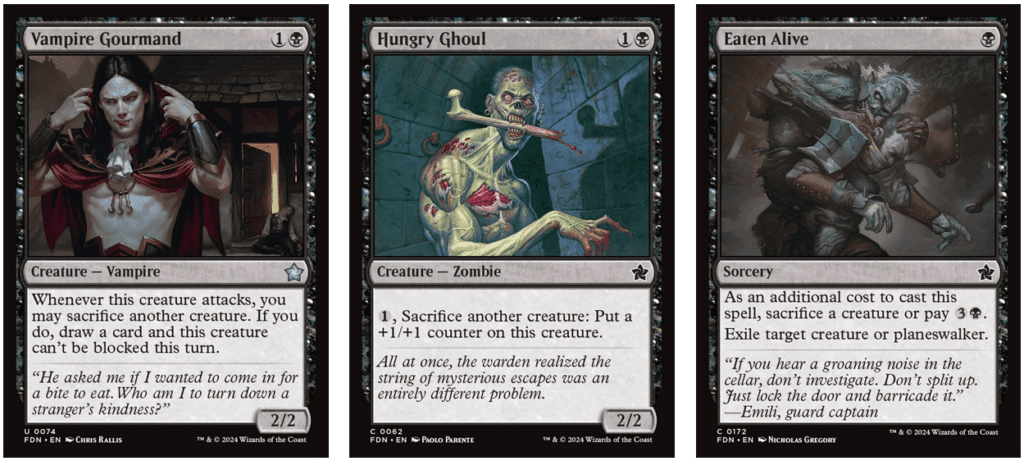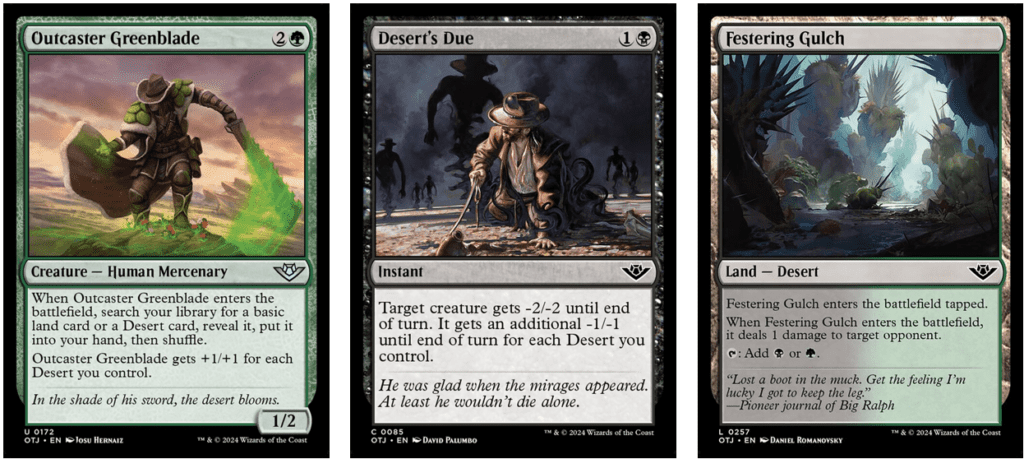In Limited Magic a build-around card is one that needs the right cards around it in order for it to pan out as an effective card in your deck. In other words, you usually have to “build-around” it.
Typically, this term gets used for cards that ask for some type of synergy that isn’t one of the main themes in a set. In other words, you wouldn’t typically call a signpost Uncommon like Empyrean Eagle a build-around card. This is because if you’re in Blue-White in Foundations, you don’t really have to go out of your way to end up in a deck with a bunch of fliers. It just happens naturally.
However, you would call Mischievous Mystic a build-around card. This is because it pays you off for doing something that isn’t a major theme in the set – drawing extra cards. The Mystic does have a decent enough baseline, but if your deck doesn’t have a few ways to draw extra cards, it’s just going to be an okay card in your deck. But if you can turn the Mystic into Bitterblossom with extra draw spells, it’s going to potentially be the best card in your deck.
Build-around cards are one of the most rewarding and entertaining things about Limited, since they don’t tend to be cards that work out every time you draft them. But when they do pan out, they end up being one of the best cards in your deck. They also tend to help a Limited format feel fresh, since it gives you an additional kind of deck to build, apart from the usual 10 color pairs.
In this article, I’m going to give my picks for the year’s best build-around cards, and discuss how best to abuse them in their respective Limited formats.
NINE-LIVES FAMILIAR
While we’re on the topic of Foundations, let’s take a look at my favorite build-around from the set. The Familiar has a really flavorful design, in that it’s a cat that effectively has nine lives. It enters with eight counters, and whenever it dies if it had a counter, it returns to the battlefield with one less counter on your next end step.
In a vacuum, that’s not really a Limited card that’s worth it. Chump blocking all day just isn’t a very effective use of your mana or your cards, but if you combine Nine-Lives Familiar with a critical mass of sacrifice effects, it gets ridiculous in a hurry.
While Foundations didn’t have a sacrifice color pair per se, Black is loaded up with good sacrifice outlets. Chief among these is Vampire Gourmand, which can turn each of the familiar’s lives into a card, but sacrificing the Familiar to Hungry Ghoul or Eaten Alive feels pretty great too.
You do need to have lots of sacrifice outlets to make the Familiar worth it, though. Especially because the set features other cards that are much better on their own that are also good sacrifice fodder – like Infestation Sage and Burglar Rat.
That’s what makes the Familiar a true build around. If you don’t get there on a ton of nice sacrifice effects, you just can’t play it.
SMOKY LOUNGE // MISTY SALON
I mentioned in the introduction hat most signpost Uncommons aren’t what I would call build-around cards, but this is the exception that proves the rule. Generally speaking, it’s better for Limited when signposts work really well in every deck within their color pair, but it can be fun on occasion to make a signpost Uncommon like this one.
Smoky Lounge // Misty Salon takes a ton of work, but it is possible to build decks where it wins you the game. Part of the problem with the card is that the Smoky Lounge side doesn’t add to the board at all, which is always a problem in Limited. However, the Misty Salon side does, giving you a flying creature token when you unlock it.
While most decks in Duskmourn have at least a few doors, the number of doors that Smoky Lounge // Misty Salon needs in order to function just isn’t doable draft in and draft out. However, it’s not impossible either. And when you can make 4/4 and 5/5 tokens with Misty Salon, it can definitely close out the game.
To survive long enough to win the game with this Room, while also setting it up, you need to end up with lots of cheaper Doors that do impact the board and slow the game down. Luckily, Blue and Red have lots of Uncommon and Common doors that are up to the task.
Bottomless Pool can bounce opposing creatures, Meat Locker can stun them, and Glassworks can destroy them.
CONSUMING CORRUPTION
Almost all Limited decks are two or more colors. This is because the way booster packs are constructed, it just usually isn’t a good idea to stick to one color. If you do, you end up with weaker cards than the players around you, who will be taking the best cards in two colors instead of one.
So, when a card comes along that pays you off for going really hard in one color in particular, it can really shake things up. Most cards that try to push you in this direction really aren’t worth it (I’m looking at you, Blanchwood Armor), but Consuming Corruption is a rare example of a card that gets there.
You can’t play Corruption unless your deck is mono-black or really close to it, but once you make that commitment, it quickly becomes the best card in your deck. It’s capable of killing just about anything while gaining you a ton of life. Destroying a creature and gaining a lot of life is one of the best feelings in Magic. It usually shifts a game wildly in your favor.
OUTCASTER GREENBLADE & DESERT’S DUE
Desert decks were very real in Outlaws of Thunder Junction. The set had a cycle of 10 desert dual lands which could make your mana very consistent, and Outcaster Greenblade and Desert’s Due gave you two super powerful payoffs at lower rarities.
Neither of them are what you want to be playing if your deck has 0 deserts in it, but as long as you have a few of them they perform quite well, and it wasn’t unheard of to end up with 7+ in the format.
The Greenblade could make your mana excellent while also becoming a very real threat in the most desert heavy of decks. Desert’s Due goes from being a subpar removal to spell to a very good one with even one Desert in play, and by the later stages of the game it can take down just about anything.
The Desert decks helped make Outlaws of Thunder Junction a lot more interesting than it would have been otherwise. It even made it much easier to play multiple colors, keeping the format fresh even 50 drafts in.
Decks that are built around a land subtype are always a lot of fun when they pan out. It’s too bad Caves in Lost Caverns of Ixalan didn’t work in Limited.
BUILDER’S TALENT
Builder’s Talent is by far my favorite build-around card of the year. It ended up being a very viable card in Bloomburrow Limited, and that was great – because that format was probably the least interesting one we saw in 2024. Typal archetypes are fun and all, but they get old fast.
Builder’s Talent gave you a different direction to go in, and it was a very powerful direction indeed. While getting the 0/4 isn’t what makes the card fun, it’s kind of like eating your vegetables. If it weren’t for that base effect, Builder’s Talent wouldn’t be nearly as good, because your chances of getting to Level 2 and Level 3 would go down significantly.
Once you do take the Talent to Level 2, it becomes quite the value engine. Bloomburrow was loaded up with really good noncreature nonland permanents that would give you +1/+1 counters. This includes other classes as well as food like Carrot Cake and Bumbleflower’s Sharepot.
Sharepot + Builder’s Talent was perhaps the sweetest combo. It gives you two +1/+1 counters of course, but then you can use it to destroy a nonland permanent. Then, if you take Builder’s Talent to Level 3, you get it back along with two more counters, and then you can destroy something else.
Builder’s Talent got particularly absurd in multiples, and it was by far the most fun I ever had in Bloomburrow Limited.
END STEP
I had a lot of fun with these build-around cards this year. I’m sure we’ll get some more great ones in 2025. What about you? What build-around cards did you enjoy the most this year? Let me know over on X.

Jacob has been playing Magic for the better part of 24 years, and he especially loves playing Magic’s Limited formats. He also holds a PhD in history from the University of Oklahoma. In 2015, he started his YouTube channel, “Nizzahon Magic,” where he combines his interests with many videos covering Magic’s competitive history. When he’s not playing Magic or making Magic content, he can be found teaching college-level history courses or caring for a menagerie of pets with his wife.







